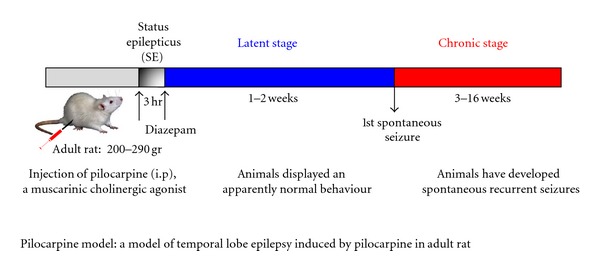Figure 2.

Scheme illustrating a model of temporal lobe epilepsy induced by pilocarpine in adult rat. Adult rats were injected intraperitoneally (i.p.) with pilocarpine hydrochloride, a muscarinic cholinergic agonist. The injection produces a status epilepticus (SE) that is stopped after 3 hr by a single injection of diazepam to reduce mortality of the animals. The rats were then observed periodically in the vivarium for general behavior and occurrence of spontaneous seizures for a period of 16 weeks. Pilocarpine-treated animals were analyzed at several postinjection intervals: during the latent period, when animals displayed an apparently normal behavior (1 and 2 weeks), and during the chronic stage, when the animals have developed spontaneous recurrent limbic seizures (8–16 weeks). It has been previously demonstrated in this model of pilocarpine-treated rats, by using in vivo electroencephalographic recordings that the first spontaneous seizures occur during the third week after status epilepticus [46]. In this model, a dynamic reorganization of the glutamatergic network, including neurodegeneration, neurogenesis, neo-spinogenesis, spine morphogenesis, and neo-synaptogenesis associated with an aberrant sprouting of granule cell axons, is well established in the dentate gyrus.
